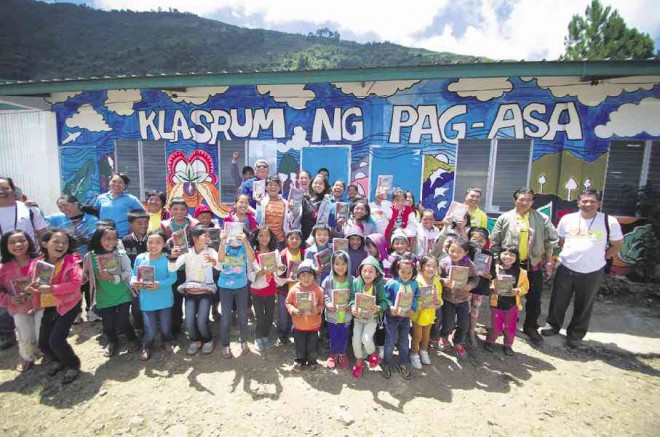
STUDENTS of Lebeng Primary School in Sitio Lebeng, Barangay Bashoy, Kabayan in Benguet province, together with DepEd Undersecretary of Partnerships and External Linkages Mario A. Deriquito (in blue shirt) and Angelo Valencia (wearing sunglasses at the right side) of “Klasrum ng Pag-asa,” raise their learners’ kits donated by private companies during the DepEd Brigada Eskwela 2015. Richard Balonglong/INQUIRER NORTHERN LUZON
KABAYAN, Benguet—A team from the Department of Education (DepEd) visited recently what are literally the coldest schools in the country, taking in firsthand the problems they need to solve and fulfill the promise of the K-12 basic education program.
Mt. Pulag Elementary School and Lebeng Primary School in Barangay (village) Babalak and Adaoay National High School in Abucot Extension, both in Kabayan town, Benguet province, are near Mt. Pulag, Luzon’s highest peak at 2,360 meters (7,740 feet) above sea level.
A DepEd team, led by Education Undersecretary Mario Deriquito, climbed Pulag to launch a Brigada Eskwela program there from May 18 to 23, and was told about problems felt in many other areas of the country: lack of classrooms, teachers and resources.
But the impact of these problems on mountain schoolchildren is different. For example, these are schools where temperatures drop to as low as minus 1 degree Celsius.
Pulag, a favorite trekking destination, was once considered the home of Ibaloy deities. It is one of the country’s remaining natural forests and is surrounded by communities that thrive on vegetable gardening.
Deriquito acknowledged the DepEd’s challenges: “I saw the situation … how far [the schools are]. The roads from home to school are rough; it’s difficult. Imagine that for us adults we find it difficult, how much more for the kids.”
“But the community makes an effort for the children to be educated, and that makes us glad,” he said.
“At present, we have no rooms to accommodate kindergarten pupils and Grade 4 students. We have no teachers for junior and senior high school students,” said Mary Anape, the head teacher overseeing Pulag Elementary School and Adaoay National High School.
She said two more teachers were needed to handle kindergarten and Grade 4 classes.
“We also need to repair our buildings. The walls have holes. We need more chairs especially for the kindergarten pupils,” she said.
Adaoay teacher-in-charge, Arnold Manid, said this school, too, had problems that should be addressed before 2016 when the senior high school program is implemented.
“We need rooms for [our] home economics [subject], a faculty office, and a computer room. We need at least seven rooms to accommodate all [new students], now that we have K-12,” he said.
The parents and teachers who gathered to meet the DepEd team said they managed to cope, donating things to keep the schools operating.
Some neighbors even gave up their farms to the community so that an additional school and playground could be put up.
In an assembly joined by Deriquito, many members of the community expressed some reservations about the K-12 program.
“Some are trying to go against it [the K-12 program], but it is now a law. The contentions against K-12 should have been presented during the deliberation [of Republic Act No. 10533 or the Enhanced Basic Education Law] in the Senate, not today because it has become a law,” said Federico Martin, Benguet division schools superintendent.
“You cannot abort a program that has already started, just like a baby who was already born. We have to continue with the K-12 program and Benguet division is determined to implement it,” he said.
The DepEd team distributed 530 school uniforms and 561 learners’ kits donated by companies.
Volunteer groups from Metro Manila helped put up additional classrooms. “Klasrum ng Pag-asa,” an initiative of lawyer Angelo Valencia, spent for two new classrooms and other facilities at Adaoay National High School.
Members of the group Art Attack have been frequenting schools around Pulag, and have painted murals to brighten up the classrooms.
During the Brigada Eskwela week, the group “Para sa Sining Production” performed songs, while volunteer photographers from “Juan Portrait,” led by lawyer Chris Linag, gave free ID pictures and printed cards for the students.

